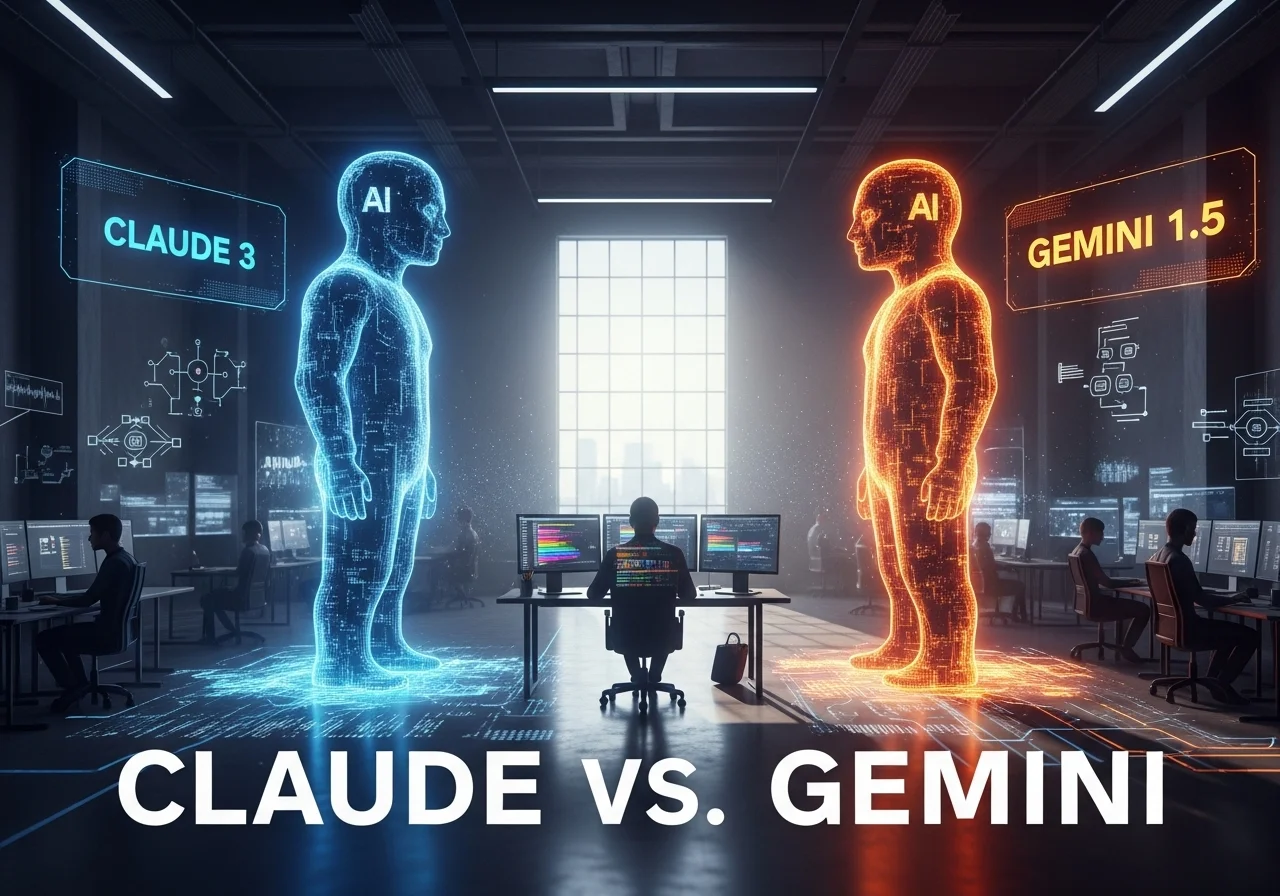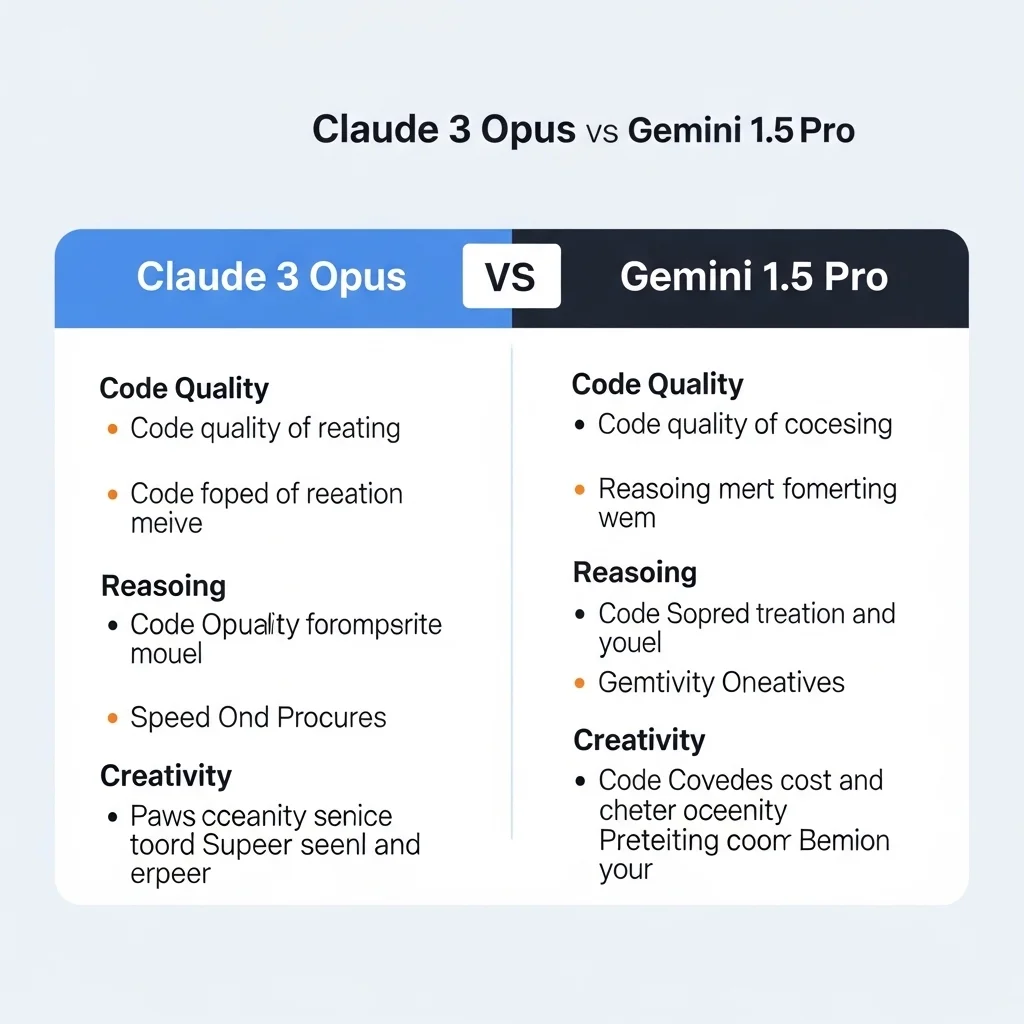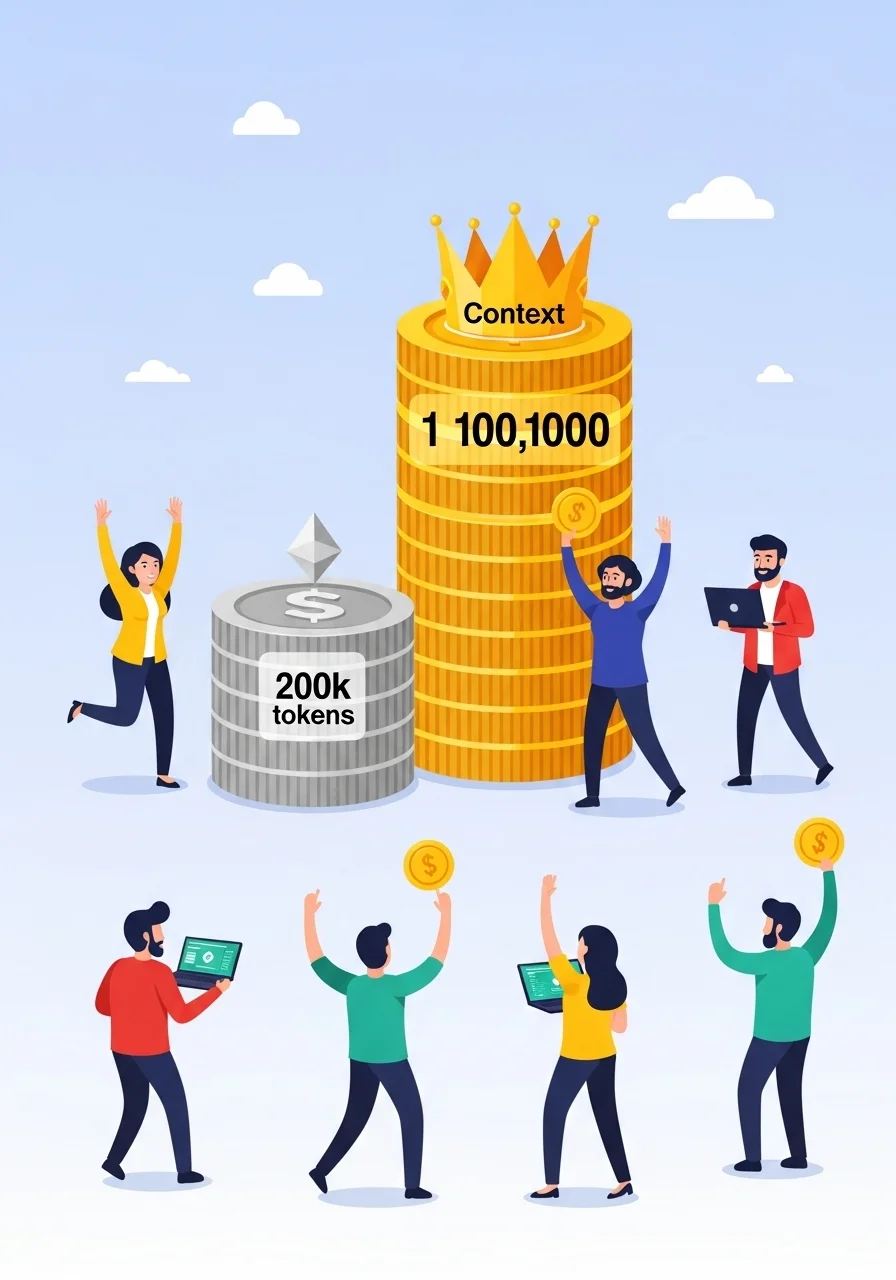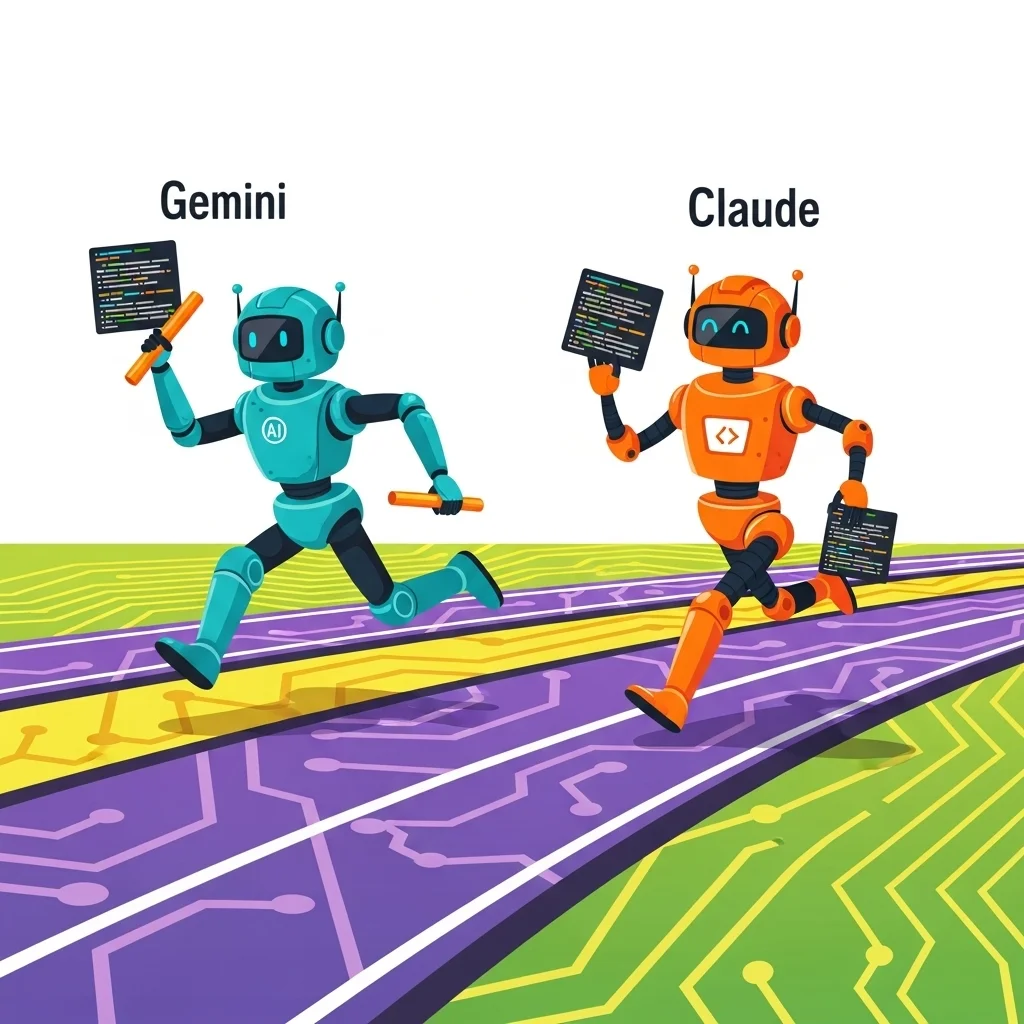Bedankt voor uw bericht!
We nemen zo snel mogelijk contact met u op.
Contact opnemen?
Heeft u vragen over dit artikel of onze services? Neem contact op!
Claude vs. Gemini: Who Wins the Battle for the Best Code?

As a development team we dive into the newest AI assistants every day. We pit the two titans, Claude 3 and Gemini 1.5, against each other and share our unfiltered opinion on which tool is the best partner for the modern developer.
Claude vs. Gemini: Who Wins the Battle for the Best Code?
As a development team we dive into the newest AI assistants every day. We pit the two titans, Claude 3 and Gemini 1.5, against each other and share our unfiltered opinion on which tool is the best partner for the modern developer.
The new colleague who never sleeps
Clash of the Titans
More than just code: it is about workflow and brainpower
Context is king
Gemini 1.5 Pro takes the crown with its experimental one-million-token context window, letting you analyse an entire codebase in one go. Claude 3 Opus comes in a strong second with 200k tokens, perfect for overseeing large features or repositories.
Code quality
Claude 3 Opus often feels like a senior developer: the code is elegant, well structured and follows best practices. Gemini 1.5 Pro is a lightning-fast creative thinker that sometimes delivers surprising, though not always equally polished, solutions.
Reasoning & debugging
This is where Claude 3 shines. The model shows a deeper grasp of the *intent* behind the code, which helps track down complex logical bugs. Gemini is great at quickly scanning large files for errors but occasionally misses the deeper reasoning layer.
Speed & creativity
Gemini generally feels faster and responds more snappily, ideal for quick questions and generating boilerplate code. The model is also more creative when suggesting alternative approaches, which can spark unexpected innovations in your project.

The context revolution: a game-changer for legacy projects?
Why a big 'memory' is the difference between a gimmick and an indispensable tool
Have you ever wondered what it would be like to feed an AI an entire project at once? Not just a handful of files, but the client's whole, history-laden codebase? That is the promise Google in particular is making with Gemini 1.5 Pro, and it is a development we at Spartner are watching with eagle eyes.
Recently we faced an interesting challenge: modernising an older application riddled with dependencies and lacking documentation. A typical project where a developer can spend weeks untangling the logic. Instead of slogging through it manually, we decided to use it as a perfect test case for the new generation of AI assistants. We fed a substantial part of the codebase to both Claude 3 Opus and Gemini 1.5 Pro.
The result was stunning. Where older models would stumble, these two giants immediately started mapping out the application.
* **Gemini 1.5 Pro:** With its gigantic one-million-token context window (roughly 1,500 pages of text or an hour of video!) we could upload almost the entire backend in one go. The model acted like a super-analyst: it identified hidden relationships between modules, flagged outdated packages and even proposed a migration plan. The sheer scale at which it could process information was unprecedented.
* **Claude 3 Opus:** Although the 200k-token window is 'smaller', we noticed a different kind of intelligence. Claude was better at 'understanding' the business logic hidden in the code. It did not just state *what* a function did but also *why* it was probably written that way. This deeper reasoning power is worth gold when refactoring because it helps respect the original intent.
What does this mean in practice? The AI is no longer a glorified search engine for code snippets. It is becoming a fully-fledged sparring partner that can oversee the complete context of a project. For us as a development team this means a huge acceleration in onboarding complex projects and a powerful weapon in the fight against technical debt. It is no longer science fiction; it is a tangible advantage we are already using today.

How do you pick the right AI colleague for your team?
A practical roadmap for a successful integration
**Step 1: Define your primary headache**
Where do you lose the most time? Is it setting up new projects (boilerplate code)? Getting to grips with someone else’s code? Writing unit tests? Or perhaps debugging impossible errors? Be honest about your weak spots.
* **Pro tip:** Make a list. For quick scripts and boilerplate, Gemini’s speed might be ideal. For complex refactoring and understanding legacy code we tend to favour Claude’s reasoning power.
**Step 2: Run a head-to-head pilot**
Pick a well-defined, realistic task. For example, a recent bug or a small feature request. Give *exactly the same* prompt to both Claude 3 and Gemini 1.5. Compare not just the generated code.
* **Pay special attention to this:** How many iterations did you need to reach the right solution? Which model understood your question better straight away? Whose code was easier to integrate into your existing codebase? The developer experience is the decisive factor here.
**Step 3: Integrate with your existing tools**
An AI assistant is most valuable when it fits seamlessly into your daily environment. Both Google and Anthropic offer APIs, and there are countless plugins for IDEs like VS Code or PhpStorm.
* **Our experience:** Friction needs to be minimal. If you constantly have to switch between your editor and a web interface, you lose the productivity boost. Invest time in setting up a solid integration. This is where the real productivity gains are made.
**Step 4: Train your 'prompt muscle'**
Learning to communicate with an AI is a new skill. Vague questions lead to vague answers. Treat the AI like a junior developer you are coaching: provide context, define the desired result, give examples and specify the definition of done.
* **Handy trick:** Start your prompts by assigning a role. "You are a senior Laravel developer specialising in security. Write middleware that does X, Y and Z." This framing helps the model deliver more relevant, higher-quality output.

Day-to-day reality: snippets, systems and the search for 'flow'
Beyond the benchmarks and the marketing hype, how do we *really* use these tools?
Okay, the large context windows are impressive. But what does the choice between Claude and Gemini mean for a developer's daily tasks? The truth is more nuanced than 'one is better than the other'. It is about using the right tool at the right moment.
**For fast, creative work: Team Gemini**
Imagine it is Monday morning and you need to build a proof of concept for a new API integration. The exact specs are still unclear, but you want to show something working quickly. This is where Gemini 1.5 Pro shines. You toss in a few ideas and within seconds you get multiple, often surprisingly creative, options back.
* **Real-world example:** We recently had to write a complex data-transformation script. We asked Gemini for an approach in Python. It offered the standard solution but also suggested an alternative using the `pandas` library that we had not immediately considered. It was faster and more elegant. Gemini is that colleague who always has an unexpected angle, keeping your thinking sharp. The speed and the out-of-the-box suggestions make it perfect for the exploratory phase of a project.
**For depth and quality: Team Claude**
Now another scenario: you are working on the core of a complex financial application. A bug here could have disastrous consequences. You need to refactor an existing function without breaking the underlying logic. This is when we increasingly turn to Claude 3 Opus.
* **Personal insight:** What strikes me is that Claude seems to have more 'patience'. The code it generates is often more meticulous. It adds comments at crucial points, uses more meaningful variable names and the structure feels as if an experienced architect has thought it through. While refactoring that financial module, Claude analysed the input and output and proactively warned about edge cases the original developer had not considered. That extra layer of reasoning and quality awareness inspires the confidence that is essential in high-stakes development.
The conclusion for our team is clear: we are not exclusive to either of them. We use them interchangeably depending on the task. Gemini is our sprinter for a quick start and creative input. Claude is our marathon runner for the complex, critical parts where quality and reliability come first. The real art is knowing which 'colleague' to ask for help.

The verdict: a draw with two winners
The real winner is the developer who learns how to get the best out of both tools
It feels almost anticlimactic, but after weeks of testing and integrating them into our daily processes there is no definitive winner in the battle between Claude and Gemini. And honestly, that is fantastic news. The competition between Anthropic and Google pushes innovation to great heights, and we as developers reap the benefits. What we have learned is that the question should not be "which is better?" but "which is better *for this specific task*?"
My personal observation is that we are on the brink of a fundamental change in what it means to develop software. The AI assistant is shifting from simple code autocomplete to an active partner in the creative and analytical process.
* **It is not a replacement, it is a lever:** These tools do not make a good developer redundant. They make a good developer more productive, more creative and able to tackle more complex problems.
* **Context is the new currency:** Models that can process and understand the most context will deliver the most value for complex, real-world projects.
* **Prompt engineering is a core competency:** The quality of the output is directly related to the quality of the input. Investing in training your team to communicate effectively with AI is crucial.
* **Specialise your toolkit:** Just as you would not use one programming language for everything, you should not use one AI model for every task. Learn each model’s strengths and weaknesses.
Your turn: which AI assistant powers your code?
The debate is far from over and we are curious about your experience
This is our analysis from the trenches of software development, but the technology evolves daily. What experience do you have with Claude 3 or Gemini 1.5 in your projects? Do you see the same patterns, or do you have totally different insights?
Share your thoughts and experiences in the comments below. Or, if you want to spar more deeply about how AI can transform your development workflow, let’s grab a virtual coffee. We build the future of software together, and this conversation has only just begun.
Frequently asked questions about the AI code revolution
The most pressing questions we get from clients and colleagues, answered honestly
**Question: Could Claude and Gemini eventually replace developers?**
Answer: In the short and medium term absolutely not. They replace tasks, not roles. Repetitive work such as boilerplate, basic unit tests and simple scripts is automated, but architecture, complex problem solving, business analysis and ultimate accountability remain human work. In our experience the AI gives the existing developer a 'superpower', it is not a replacement.
**Question: Which model is better for a specific language such as PHP or JavaScript?**
Answer: Both models have been trained extensively on public code and perform excellently in all major languages. We see a slight preference for Claude 3 when it comes to generating code that follows the best practices of a specific framework (such as Laravel or Symfony in PHP). Gemini can be a bit more generic, but a good prompt often corrects this. In practice the difference is minimal.
**Question: Is such a gigantic context window really useful in day-to-day work?**
Answer: Yes, and it is becoming more useful by the day. For a simple function it is overkill. But for onboarding a large, unfamiliar project, performing project-wide refactoring or hunting down a bug that seeps through multiple layers of the application, it is a total game-changer. It lets the AI make connections that would take a human hours or days to find.
**Question: What are the risks regarding security and intellectual property?**
Answer: This is a crucial question. It is essential to read the terms of the APIs you use carefully. Most paid APIs (from OpenAI, Google and Anthropic, for example) do not use the data you send in to train their models. Nevertheless, you must be extremely careful about entering sensitive data such as API keys, passwords or personal data. Implement internal guidelines and use tools that can anonymise data where needed.
**Question: How do these models handle very complex, abstract logic?**
Answer: They are getting better, but this is still where the limit of their capability meets the strength of a human expert. They can perfectly implement well-known algorithms, but designing a completely new, complex algorithm for a unique business problem is still a human task. The AI is a brilliant assistant to help structure your thoughts, write the code and test edge cases, but the initial creative concept still comes from the developer.
Bedankt voor uw bericht!
We nemen zo snel mogelijk contact met u op.
Contact opnemen?
Heeft u vragen over dit artikel of onze services? Neem contact op!
Feel like a cup of coffee?
Whether you have a new idea or an existing system that needs attention?
We are happy to have a conversation with you.
Call, email, or message us on WhatsApp.
